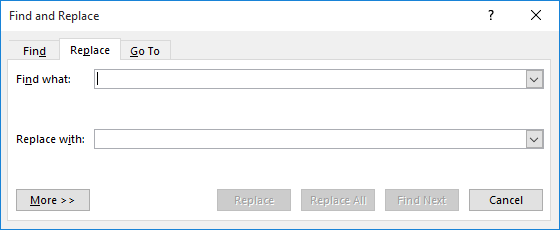Please Note: This article is written for users of the following Microsoft Word versions: 2007, 2010, 2013, 2016, 2019, and 2021. If you are using an earlier version (Word 2003 or earlier), this tip may not work for you. For a version of this tip written specifically for earlier versions of Word, click here: Replacing with Plain Text.
Written by Allen Wyatt (last updated May 8, 2021)
This tip applies to Word 2007, 2010, 2013, 2016, 2019, and 2021
If you use Word's Find and Replace tool to search for text and replace it with other text, Word applies to the replacement text the character attributes it found in the first character of the Find What text. For example, if you search for "Highlight is a brief review," and the word "Highlight" is in italics in the document, then the entire replacement string is formatted as italics by Word.
This behavior is by design; Word needs to pick some sort of formatting for the replacement text, so it bases it on the first character of what is being replaced. In most cases this isn't a problem, but in some cases (such as when the replacement text needs to have several character attributes) it can be a problem.
One solution is to use the formatting capabilities of the Find and Replace tool. When setting up your search, make sure the insertion point is in the Replace With box and then use the Format drop-down list to choose what formatting you want applied to the replacement text. If you don't want it to have any formatting, then you can choose Format | Font and make sure that Regular Text is selected.
If your formatting needs are more complex than forcing a plain-text replacement, then this simplistic approach won't work. For instance, you might want to replace "Highlight is a brief review" with "Highlights is a magazine for children," and both "Highlight" and "Highlights" were the only text to appear in italics. In this case, you need to rely on a more esoteric feature of the Find and Replace tool.

Figure 1. The Replace tab of the Find and Replace dialog box.
Word finds whatever text you specified in step 4 and replaces it with the contents of the Clipboard, which happens to be your formatted replacement text.
WordTips is your source for cost-effective Microsoft Word training. (Microsoft Word is the most popular word processing software in the world.) This tip (9355) applies to Microsoft Word 2007, 2010, 2013, 2016, 2019, and 2021. You can find a version of this tip for the older menu interface of Word here: Replacing with Plain Text.

Discover the Power of Microsoft Office This beginner-friendly guide reveals the expert tips and strategies you need to skyrocket your productivity and use Office 365 like a pro. Mastering software like Word, Excel, and PowerPoint is essential to be more efficient and advance your career. Simple lessons guide you through every step, providing the knowledge you need to get started. Check out Microsoft Office 365 For Beginners today!
Need to know how many paragraphs are in a document? You can use Word's Find and Replace feature to get a count quickly.
Discover MoreThe Find and Replace tool can get rid of trailing spaces in paragraphs quite nicely. If those spaces are at the end of ...
Discover MoreIf you have a document that contains optional hyphens (special characters that mark where a word can be split between ...
Discover MoreFREE SERVICE: Get tips like this every week in WordTips, a free productivity newsletter. Enter your address and click "Subscribe."
There are currently no comments for this tip. (Be the first to leave your comment—just use the simple form above!)
Got a version of Word that uses the ribbon interface (Word 2007 or later)? This site is for you! If you use an earlier version of Word, visit our WordTips site focusing on the menu interface.
Visit the WordTips channel on YouTube
FREE SERVICE: Get tips like this every week in WordTips, a free productivity newsletter. Enter your address and click "Subscribe."
Copyright © 2025 Sharon Parq Associates, Inc.
Comments